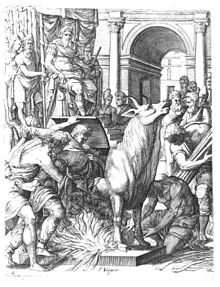7 Most Gruesome and Disturbing Torture Methods
October 2, 2017

Ever since the idea of a ruler in power was established, there have been people opposed to them.
There is simply no pleasing everyone. In order to deter those who dare to oppose or fight the power, those rebelling against people in power, invariably end up in less than enviable positions – they are either murdered, exiled, or (the topic of this article) mercilessly tortured.
The thirst for bloodshed, combined with a touch of sadism, meant that torture methods throughout history were more and more twisted and brutal.
Listed below are the top 7 most gruesome torture methods ever.

1. The Rat
Employed in: Medieval Europe
The first on this cringe-inducing list of torture methods involves everyone’s least favorite rodent – the rat.
The premise was simple; put a five-sided box on the chest of the individual being tortured, with the sixth wall opening into the person’s chest. Place a rat inside said box.
Now, put a heater on the ceiling of the box. The rat’s natural instinct is to flee the box, and it does so by burrowing through and gnawing at the person’s internal organs, often to gruesome and fatal effect.
2. Chinese Water Torture
Employed in: China, Spain
Despite the name suggesting otherwise, the discovery of Chinese Water Torture is accredited to an Italian scholar by the name of Hippolytus de Marsiliis.
He noticed how water slowly dripping onto a stone eventually hollows it out. He applied the same idea to the human body - thus, the Chinese Water Torture method was invented.
The wrongdoers were usually stripped naked in front of a crowd – who would be in the throes of mocking and jeering at them – and strapped down to a table.
Water is then slowly dripped on a small sensitive area of the body, often the forehead, given its sensitivity and closeness to the brain.
Victims are said to, not before long, go insane.
The combination of not knowing when the next drop would come, feeling the water beginning to eat away at the skin, being restrained, and the public humiliation, was enough to drive even the most resilient rebels insane.
3. Scaphism
Employed in: Ancient Persia
This torture method is mesmerizing in its absolutely horrifyingly sadistic nature and cold-heartedness.
Scaphism entailed encasing a victim in a wooden container of some sort, often a tub, a hollowed-out tree, or more commonly, two wooden boats on top of each other. Only the victim’s head, arms, and legs are exposed.
This is where it gets interesting/disturbing. The victim is violently force-fed milk and honey, and his/her face, arms, and legs are painted with the same mixture of milk and honey.
Eventually, the victim’s bowels would erupt, filling the wooden container with feces. Soon enough, insects begin to breed freely within the feces and begin to feed on the victim’s flesh.
The mixture painted on the face, arms and legs only invites more insects, such as flies and wasps, which sting the victim, breed on his/her skin, and generally invite torment.
Soon enough, the victim’s flesh and skin rot and decay as they are eaten alive by maggots, worms, flies, bees, and a host of other horrible insects.
It is a slow and painful death, to say the least. The torturers can even prolong the process if they wish – the famous Persian soldier Mithradates was kept alive and tortured for nearly three weeks.

4. The Brazen Bull
Employed in: Ancient Greece
This torture method was devised in Ancient Greece by a brass worker named Perillos of Athens.
Aptly termed, the Brazen Bull is a large brass bull, hollowed out from the inside with enough room to fit one unfortunate person.
Once the person was inside the bull, a large fire would be lit so as to roast the person to death.
As if that weren’t bad enough, Perillos put in a series of tubes that would serve to amplify the screams and groans of the person being tortured, said to resemble the roar of an angry bull.
What followed is now a famous cautionary tale. Perillos gifted the Brazen Bull to Phalaris, a tyrant.
Perillos, proud of his accomplishment, boasted to Phalaris, who remained disgusted and skeptical.
He told Perillos, “If your art can really produce this effect, then get inside and pretend to roar; we will see if the pipes make the sound you describe.”
As Perillos climbed into the bull, Phalaris ordered a fire to be kindled and placed under it, with the former still inside. “Let the music master be the first to play,” Phalaris cried out.
For what it’s worth, Perillos was right – the cries and screams did resemble that of an angry bull.
And yet, Phalaris did not kill Perillos while he was locked away in the bull but rather resorted to good, old-fashioned throwing him off a cliff.
However, his invention remained and was used heavily for the torture and execution of enemies throughout Ancient Greece.
It was perhaps the inspiration for the design of the Trojan Horse – the great hollowed-out structure used to sneak in Greek soldiers during the Trojan War.

5. The Rack
Employed in: Medieval Britain and France
The rack was an awful torture technique employed in Medieval Britain and France.
It required a table, rollers, ropes, and an interrogator with a dead soul. The victim was fastened to the table, wrists tied to one roller, and ankles tied to another.
As the victim was being interrogated, the rollers – which can only go forward thanks to a handle and ratchet mechanism – began to very slowly pull apart the victim’s joints, causing excruciating pain.
The increased tension in the muscles and joints eventually stretches the victim’s body too far – leading to painfully loud popping noises caused by the snapping of ligaments, cartridges, and bones.
The victim is often left behind with dislocated shoulders, hips, elbows, knees, wrists and ankles.
Furthermore, the restraining aspect of the torture rack allows for simultaneous torture methods to be applied, such as burning, piercing, or removing nails.
The rack was reportedly used in Ancient Greece, although it became popular in Medieval Britain and France.
In fact, the French, evidently not satisfied with the amount of pain the torture rack induced, sought to make it even worse. They resorted to placing spiked rollers underneath the victim’s spine - causing even more eye-watering damage.
6. Coffin Torture
Employed in: Medieval Britain
Another entry from Medieval times – it seems that that was a bad time to be on the wrong side of the law. Coffin torture isn’t particularly gruesome, but it is still rather terribly inhumane.
Coffin torture involved a human-sized (sometimes smaller) cage that would be hung up from a tree or a tall building.
The victim would be imprisoned inside the cage and left there for a specific period of time – largely dependent on the crime committed, and were sometimes left there until they died, usually of hunger or dehydration.
The victims would be left inside the cage in the blazing sun, a clear target for birds to peck at or for hungry animals to feed on.
To add insult to injury, the victim’s coffin would sometimes be hung in the middle of a pedestrian plaza, above hordes of angry mobs, who would often let their feelings be known to criminals inside the coffin by way of ruthless mockery, jeering, and throwing items.
7. Ling Chi
Employed in: China, Vietnam
Ling Chi is a Chinese phrase that translates as death by a thousand cuts, slow cutting, or lingering death. Not a fine list of translations.
It was used heavily by the Chinese and Vietnamese people until it was outlawed in the early 20th century.
It was usually reserved to punish severe wrongdoers, such as murderers and high traitors (the Chinese and Vietnamese are proud people).
Ling Chi is a slow process, in which the victim is tied roughly to a wooden frame or cross, and the torturer, armed with a large butcher’s knife, begins to methodically remove bits of flesh from the victim’s body.
There is no one specific order in which the torturer operates – it pretty much varies according to their fancy.
However, it usually involved cuts to the face and facial organs (often taking out the eyes first, heightening the level of psychological terror), arms, and legs, amputating the limbs, and finishing with a stab to the heart.
The reason this punishment was so effective is because it worked on more than one plane; physical damage (obviously), public humiliation, and punishment after death, this is because the mutilated body of the victim would never be ‘whole’ in the afterlife.
Ling Chi changed with the dynasties and according to the emperors' orders. Some ordered days of torture with literally thousands of wounds inflicted, while others wanted a relatively quick affair, satisfied with a few dozen wounds.
The Torture Never Ends
Torture methods don’t stop there, and I daresay that the human race can get a lot more creative if they are given a license to. Crucifixion, flaying, boiling – the list goes on and on.
In fact, an organization was set up (The United Nations Convention Against Torture) to stop the widespread use of these awful methods.
Not to say that it has been completely successful - horrifying stories still crop up from time to time, and who knows what’s happening behind closed doors? But it has at least managed to up the awareness of the public towards these awful actions.
